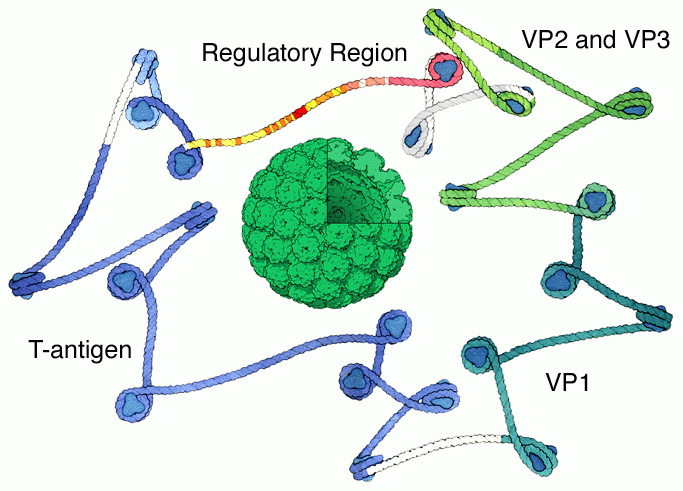|
Inhaltsübersicht | Nanomaschinen | Moleküle | Programme | Kurse | Fun | Links |
||
| > |
Simian Virus 40

Simian virus 40 is an example of how simple a virus can be and still perform its deadly job. Viruses are tiny machines with a single purpose: to reproduce themselves. They enter cells and hijack their synthetic machinery, forcing them to create new viruses. SV40 does this with very little molecular machinery. It is enclosed by a spherical capsid composed of 360 copies of one protein, seen in PDB entry 1sva, and a few copies of two others. This capsid is just big enough to enclose a small circle of DNA 5243 nucleotides long, which contains the barest minimum of information needed to get into the cell and make new viruses.
DNA Circles
The circular SV40 genome is found in the cell as a "mini-chromosome" wound into a handful of nucleosomes, as shown here. It only has enough space to encode a few functions, since it all has to fit inside the tiny capsid. It has a regulatory region, colored yellow and red here, that controls the entire lifecycle of the virus. It also encodes several proteins: the T-antigen (and a spliced version of it called the t-antigen) and three capsid proteins, VP1, VP2 and VP3. Only a few tiny segments, colored white here, are not used. Space is so limited in this genome that the capsid proteins are actually encoded with overlapping reading frames, such that the end portion of the gene for one protein also encodes for the beginning portion of the next protein. For more information on the parsimonious genome of SV40, take a look at the Protein of the Month feature at the European Bioinformatics Institute.Steering the Life Cycle
SV40 infects primate cells, forcing its way inside and releasing its DNA circle. Once inside, it has two jobs: to replicate its DNA and to package it inside new viral capsids. Amazingly, SV40 only needs one protein, the T-antigen, to control both of these processes. Soon after the virus enters the cell, the cell's own synthetic machinery recognizes a TATA sequence at the center of the SV40 regulatory regions, shown in bright red here. The cell then creates a messenger RNA reading counterclockwise around the DNA circle. This mRNA is used to make the T-antigen protein (shown in more detail on the next page). Then the virus really gets to work. The T-antigen binds to the SV40 circle and helps to separate the strands, making way for the cell's polymerases to copy the DNA. It also directs the reading of the DNA in the opposite direction, clockwise around the strand, to create many copies of the capsid proteins.SV40 and Cancer
In the normal lifecycle of the virus, SV40 enters cells, builds new viruses, and then kills the cell as the viruses are released. SV40 can also infect other mammals in a non-permissive mode. Then, the virus enters the cell but is unable to reproduce. However, T-antigen is formed and it can occasionally transform the cell into a cancer cell. The T-antigen binds to p53 and Rb, two proteins that are important in the control of growth. By blocking their normal function, the infected cell is allowed to multiply without control, leading to cancerous growth. Study of this rare event led to many of the early discoveries in the biology of cancer. More commonly, a similar mechanism allows papillomaviruses to infect cells and cause the unnatural growth of warts.Next: The Amazing T-antigen
Last changed by: A.Honegger,